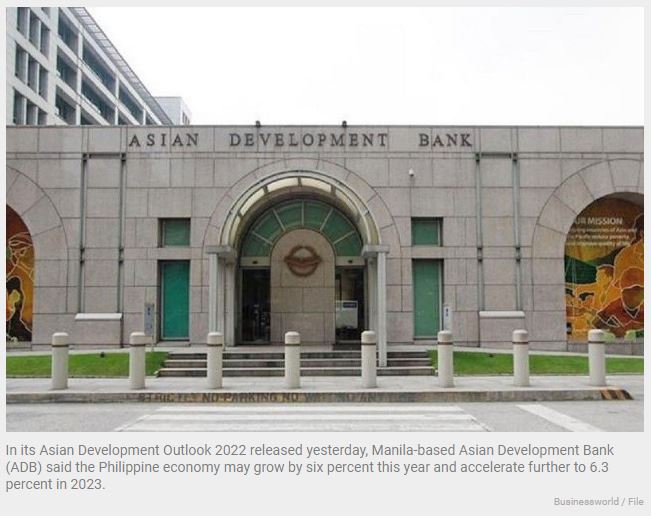ADB sees Philippines growth below target this year
MANILA, Philippines — The Philippines remains on track toward economic recovery this year as restrictions are eased, but growth may fall short of government targets as downside risks persist due to global tensions.
In its Asian Development Outlook 2022 released yesterday, Manila-based Asian Development Bank (ADB) said the Philippine economy may grow by six percent this year and accelerate further to 6.3 percent in 2023.
ADB’s gross domestic product (GDP) growth outlook for the Philippines is the same forecast it gave during its December supplement projection.
While this is an improvement from the 5.6 percent economic performance in 2021, this is still below the seven to nine percent full-year target of President Duterte’s economic team.
For this year, ADB said recovery would be underpinned by strengthening domestic investment and consumption, as several areas are placed under the lowest level of restrictions amid a drop in COVID cases.
The services sector will also get a boost from more COVID vaccination coverage and the continued relaxation of international travel.
“Nearly all indicators point to higher growth for the Philippines this year and in 2023, barring the impact of external factors from geopolitical tensions that may dampen growth globally, including in the country’s key export markets Europe and the US,” ADB country director Kelly Bird said.
The multilateral lender emphasized that the main downside risks to the outlook stem from the unpredictable sequence of global events triggered by the Russian invasion of Ukraine.
ADB argued that there is significant risk inflation could surge higher with second-round impacts, such as tightening credit markets and higher interest rates.
“Heightened and extended geopolitical tensions will dampen global growth, including in advanced economies, particularly Europe and the US, which are among the Philippines’ key export markets,” ADB said.
Further, ADB raised its inflation outlook for the Philippines this year.
The regional lender expects inflation to settle at 4.2 percent in 2022 from its earlier forecast of 3.7 percent, mainly due to rising fuel prices.
This is just slightly below the Bangko Sentral ng Pilipinas’ target of 4.3 percent.
“This is mainly on pressure from higher global oil and commodity prices. Inflation is expected to decelerate to 3.5 percent in 2023 as global commodity prices moderate,” ADB said.
In turn, the bank noted that the current account deficit is projected to widen to 3.2 percent of GDP in 2022, as faster economic growth boosts imports.
“Higher oil prices this year will also drive up import costs. Growth in merchandise exports will be moderate compared with imports. Rising remittances and services exports, including business processing outsourcing and tourism receipts, will help trim the current account deficit,” it said.
On the other hand, the bank said increased public investment in large, priority infrastructure projects would continue to boost growth, with the government aiming to sustain infrastructure spending at over five percent of GDP.
Election-related spending ahead of the May polls is also seen providing a modest lift to aggregate demand.
“Recent upticks in private investment and the passage of policy reform measures to ease rules on foreign equity ownership and lower the minimum paid-up capital of foreign retailers will support economic growth,” Bird said.
ADB emphasized that boosting revenue growth will be important to narrow the country’s deficit while meeting vital development expenditure needs.
“As economic recovery accelerates, revenue will continue to pick up. The government’s decision to maintain excise taxes on petroleum products, despite calls to suspend them to temper spikes in pump prices, will help sustain revenue,” it said.
Source: https://www.philstar.com/business/2022/04/07/2172760/adb-sees-philippines-growth-below-target-year


 English
English




